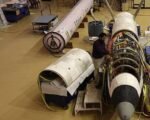Ursa Major, America’s leading privately funded company focusing solely on rocket propulsion, is establishing a new research-and-development center in Youngstown, Ohio. This center aims to advance additive manufacturing and materials development technology for liquid rocket engines and solid rocket motors. With a capital investment of $14.5 million, including $4 million in assistance from a JobsOhio R&D Grant, the center is set to enhance the production capabilities of vital national security propulsion systems. This article explores the significance of the new R&D center, its technical aspects, and the future prospects for national security propulsion technology.
The establishment of the new R&D center in Youngstown is a strategic move for Ursa Major and the broader national security landscape. The center will focus on developing advanced propulsion technologies that are essential for America’s security, including high-performance munitions, hypersonic weapons, in-space propulsion systems, and space launch capabilities. By leveraging Ohio’s manufacturing heritage and skilled workforce, the center aims to drive innovation and enhance the country’s defense capabilities.

The collaboration between Ursa Major and JobsOhio highlights the importance of public-private partnerships in advancing national security objectives. The $4 million R&D Grant from JobsOhio is a testament to the state’s commitment to supporting cutting-edge research and development initiatives. This investment will not only boost the local economy but also position Ohio as a hub for aerospace and defense innovation.
The new R&D center is expected to create job opportunities and stimulate economic growth in the region. Ursa Major plans to expand its workforce from three to eighteen people, providing high-skilled jobs in the fields of engineering, manufacturing, and research. This growth will contribute to the overall economic development of the Mahoning Valley and reinforce Ohio’s reputation as a leader in advanced manufacturing.
Technical and Operational Aspects
The technical and operational aspects of the new R&D center are centered around additive manufacturing and materials development. The center will house multiple Laser Powder Bed Fusion 3D Printers, state-of-the-art machines that enable rapid prototyping and material development. These printers will be used to develop metallic alloys for solid rocket motors and copper and nickel alloys for liquid rocket engines.
Additive manufacturing, also known as 3D printing, offers several advantages over traditional manufacturing methods. It allows for the creation of complex geometries, reduces material waste, and shortens production lead times. By utilizing additive manufacturing, the R&D center aims to accelerate the development and qualification processes for aerospace applications, ensuring that new propulsion technologies can be brought to market more quickly and efficiently.
The center’s focus on materials development is crucial for advancing propulsion technology. The development of new metallic alloys will enhance the performance and reliability of rocket engines and motors. These materials must withstand extreme temperatures and pressures, making their development a critical aspect of the R&D center’s mission. The center’s efforts will contribute to the overall advancement of propulsion technology and support the U.S. Department of Defense’s development contracts.
Future Prospects and Challenges
The future prospects for the new R&D center are promising, with significant potential for growth and innovation. The center’s work will play a vital role in advancing national security propulsion technology, ensuring that the U.S. remains at the forefront of aerospace and defense capabilities. The successful implementation of the center’s initiatives will enhance the country’s ability to develop and deploy advanced propulsion systems for a wide range of applications.
However, the center also faces several challenges that must be addressed to ensure its success. One of the key challenges is securing a stable supply chain for raw materials and components. The center’s reliance on advanced materials and manufacturing technologies requires a robust and reliable supply chain. Ursa Major will need to work closely with suppliers and partners to ensure that the necessary resources are available to support its research and development efforts.
Another challenge is the need for continuous innovation and adaptation. The field of propulsion technology is constantly evolving, with new advancements and breakthroughs emerging regularly. The R&D center must stay ahead of these developments by investing in cutting-edge research and fostering a culture of innovation. This will require ongoing collaboration with academic institutions, industry partners, and government agencies to ensure that the center remains at the forefront of technological advancements.
In conclusion, the establishment of the new R&D center in Youngstown, Ohio, represents a significant milestone for Ursa Major and the broader national security landscape. The center’s focus on additive manufacturing and materials development will drive innovation and enhance the country’s defense capabilities. With promising future prospects and a commitment to overcoming challenges, the R&D center is poised to make a lasting impact on national security propulsion technology.








